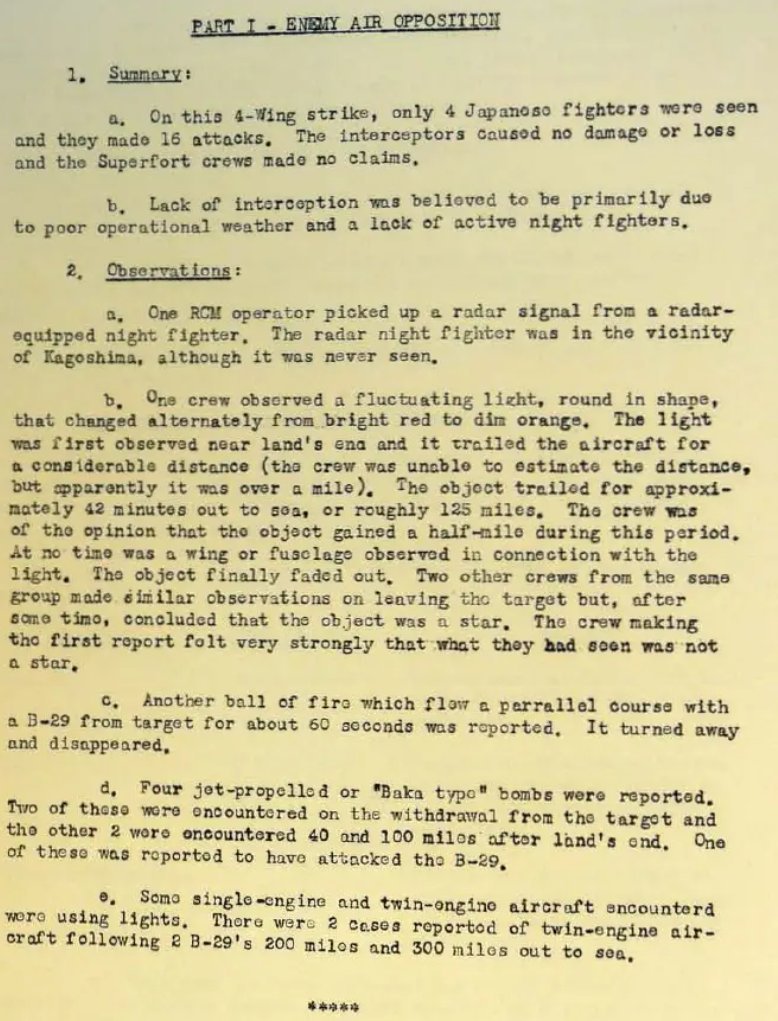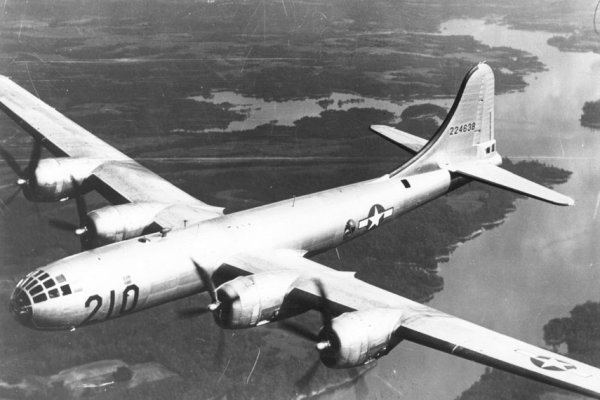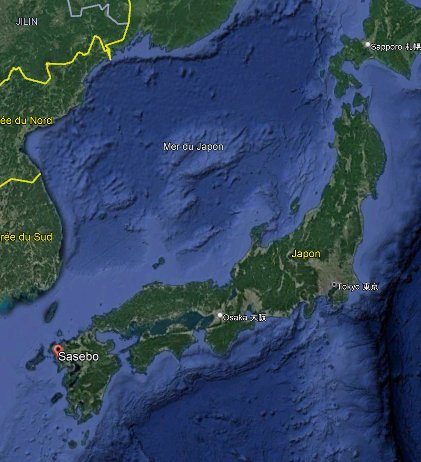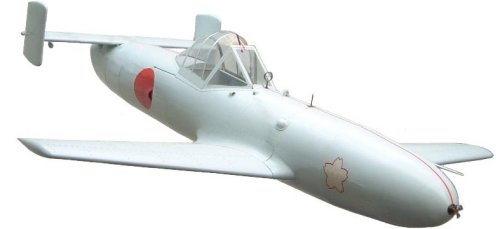ACUFO-1945-06-18-HONSHUKYUCHU-1
In the end of the 1990's, US ufologist Jan Aldrich published on his historical ufology website Project 1947 an extract from a Tactical Mission Report of the XXI Bomber Command, coming from microfilm #5, and documenting US Army Air Forces night bombing missions 206-209 of June 18, 1945, over Honshu and Kyushu, Japan. I was also able to find this document, available in the folder below.
It was indicated in this report that one crew observed a fluctuating light, round in shape, that changed alternately from bright red to dim orange. The light was first observed near land's end and it trailed the aircraft for a considerable distance. The crew was unable to estimate the distance, but apparently it was over a mile.
The object trailed for approximately 43 minutes out to sea, or roughly 125 miles. The crew was of the opinion that the object gained a half-mile during this period. At no time was a wing or fuselage observed in connection with the light. The object finally “faded out”.
Two other crews from the same group made similar observations on leaving the target but, after some time, concluded that the object was a star. The crew making the first report felt very strongly that what they had seen was not a star.
The report mentioned that another ball of fire which flew a parallel course with a B-29 from target for about 60 seconds was reported. It turned away and disappeared.
Also, four jet-propelled or “Baka-type” bombs were reported. Two of these were encountered 40 to 100 miles after land's end. One of these was reported to have attacked the B-29.
The report also stated that some single-engine and twin-engine enemy aircraft encountered were using lights, and that there were two cases reported of twin-engine aircraft following two B-29's 200 miles and 300 miles out to sea.
| Date: | June 18, 1945 |
|---|---|
| Time: | Night. |
| Duration: | ? |
| First known report date: | June 18, 1945 |
| Reporting delay: | Hours. |
| Country: | Japan |
|---|---|
| State/Department: | |
| City or place: | Honshu or Kyushu |
| Number of alleged witnesses: | Several. |
|---|---|
| Number of known witnesses: | ? |
| Number of named witnesses: | 0 |
| Reporting channel: | Military operation report. |
|---|---|
| Visibility conditions: | Night. |
| UFO observed: | Yes. |
| UFO arrival observed: | ? |
| UFO departure observed: | Yes. |
| UFO action: | None. |
| Witnesses action: | None. |
| Photographs: | No. |
| Sketch(s) by witness(es): | No. |
| Sketch(es) approved by witness(es): | No. |
| Witness(es) feelings: | ? |
| Witnesses interpretation: | Not a star, a star. |
| Sensors: |
[X] Visual: Several.
[ ] Airborne radar: [ ] Directional ground radar: [ ] Height finder ground radar: [ ] Photo: [ ] Film/video: [ ] EM Effects: [ ] Failures: [ ] Damages: |
|---|---|
| Hynek: | NL |
| Armed / unarmed: | Armed, 12 Browning M2 12,7 mm machine guns. |
| Reliability 1-3: | 3 |
| Strangeness 1-3: | 1 |
| ACUFO: | Insufficient information, possible Jupiter. |
(Ref. aaf1:) US ARMY AIR FORCES:
This report covered Bomber mission 206 to 209 flown on June 17-18, 1945, against targets on the Islands of Honshu and Kyushu.
I am giving only the parts that relate to, or are relevant to, the sighting that was picked up later by ufology sources (further below). The sighting is noted in the “Enemy Air Opposition” Intelligence part of the report; it did not distinguish between the 4 missions, flown by 4 units, the 313th, 314th, 58th, and 73rd Bombardment Wings. Because of this, the time - in the night - and precise location also cannot be established.

|
PART I - ENEMY AIR OPPOSITION
1. Summary:
a. On this 4-Wing strike, only 4 Japanese fighters were seen and they made 15 attacks. The interceptors caused no damage or loss and tho Superfort crews made no claims.
b. Lack of interception was believed to be primarily due to poor operational weather and a lack of active night fighters.
2. Observations
a. One RCM [= Radar Counter Measure equipment] operator picked up a radar signal from a radar-equipped night fighter. The radar night fightcr was in the vicinity of Kagoshima, although it was never seen.
b. One crew observed a fluctuating light, round 1n shape, that changed alternatively from bright red to dim orange. The light was first observed near land's end and it trailed the aircraft for a considerable distance (the crew was unable to estimates the distance, but apparently it was over a mile). The object trailed for approximately 42 minutes out to sea, or roughly 125 miles. The crew was in the opinion that the object gained a half-mile during this period. At no time was a wing or fuselage observed in connection with the light. The object finally faded out. Two other crews from the same group made similar observations on leaving the target but, after some time, concluded that the object was a star. The crew making the first report felt very strongly that what they had seen was not a star.
c. Another ball of fire which flew a parallel course with a B-29 from target for about 60 seconds was reported. It turned away and disappeared.
d. Four jet-propelled or “Baka-type” bombs were reported. Two of these were encountered on the withdrawal from the target and 2 were encountered 40 and 100 miles after land's end. One of these was reported to have attacked the B-29.
e. Some single-engine and twin-eng1ne aircraft encountered were using lights. There were 2 cases reported of twin-engine aircraft following 2 B-29's 200 miles and 300 miles out to sea.
(Ref. prt1:) JAN ALDRICH - "PROJECT 1947":
Missions 206-209, 18 June 1945, Honshu and Kyushu night strikes.
Under Part I “ENEMY AIR OPPOSITION”
2. Observations:
One crew observed a fluctuating light, round in shape, that changed alternately from bright red to dim orange. The light was first observed near land's end and it trailed the aircraft for a considerable distance (the crew was unable to estimate the distance, but apparently it was over a mile). The object trailed for approximately 43 minutes out to sea, or roughly 125 miles. The crew was of the opinion that the object gained a half-mile during this period. At no time was a wing or fuselage observed in connection with the light. The object finally faded out. Two other crews from the same group made similar observations on leaving the target but, after some time, concluded that the object was a star. The crew making the first report felt very strongly that what they had seen was not a star.
Another ball of fire which flew a parrallel (sic) course with a B-29 from target for about 60 seconds was reported. It turned away and disappeared.
Four jet-propelled or 'Baka-type' bombs were reported. Two of these were encountered 40 to 100 miles after land's end. One of these was reported to have attacked the B-29.
Some single-engine and twin-engine aircraft encountered were using lights. There were 2 cases reported of twin-engine aircraft following 2 B-29's 200 miles and 300 miles out to sea.
[Ref. dwn2:] DOMINIQUE WEINSTEIN:
The XXI Bomber Command conducted a night raid against urban targets on the main Japanese islands of Kyushu and Honshu. One crew reported that a ball of fire paced their B-29, flying parallel for about one minute, before it aborted its pursuit and disappeared. Another crew observed a fluctuating light, round in shape that changed alternately from bright red to dim orange. The light was first observed near land's end it trailed the aircraft for a considerable distance (according to the crew it was over a mile). The object trailed for approximately 42 minutes out to sea or roughly 125 miles. The object gained a half mile during this period. At no time was a wing or fuselage observed in connection with the light.
Sources: Headquarters XXI Bomber Command Tactical Mission Report, June 17/18, 1945, NARA / Strange Company, Keith Chester, 2007.
[Ref. sua1:] WEBSITE "SATURDAY NIGHT UFORIA":
And again on June 18, 1945, on a mission targeting Kyushu and Honshu, from the Tactical Mission Report...
One crew observed a fluctuating light, round in shape that changed alternately from bright red to dim orange. The light was first observed near land's end and it trailed the aircraft for a considerable distance (the crew was unable to estimate the distance, but apparently it was over a mile). The object trailed for approximately 42 minutes out to sea, or roughly 125 miles. The crew was of the opinion that the object gained a half-mile during this period. At no time was a wing or fuselage observed in connection with the light. The object finally faded out. Two other crews from the same group made similar observations on leaving the target but, after some time, concluded that the object was a star. The crew making the first report felt very strongly that it was not a star.
(Ref. nip1:) "THE NICAP WEBSITE":
June 18, 1945; Japan
A fluctuating light round in shape that changed from bright red, to dim orange. (Page 180 Ref.1)
The reference 1 is described at the end of the document as “Strange Company (2007), Keith Chester”.
The Boeing B-29 “Superfortress” was the heaviest bomber of the U.S. Army Air Forces, used in operations from May 8, 1944 and on. Its maximum speed was 574 km/h.
Its defensive armament was 12 Browning M2 12.7 mm machine guns.

|
Weinstein [dwn2] locates the case “near Sasebo”; but the initial, only, source, [prt1], says nothing of the sort. It only tells it occurred during strikes over Honshu and Kyushu. Honshu is the central island of Japan, Kyushu is the Japan island of the southwest.

|
In all ufology sources, the date is given as June 18, 1945. The mission report was about missions of June 17 to 18, 1945. Because the sighting occurred during the return of the bomber to base, I suppose everyone guessed it occurred after midnight. But as no time is given in the mission report, this is plausible but not factual.
The report indicates that two “Baka-type” flying bombs were seen during the missions. “Baka” was the Allies code-name for the Yokosuka MXY-7 “Ohka” Japanese aircraft.
“Baka” (photo below) was a rocket-powered human-piloted kamikaze attack aircraft used by the Japanese air forces against Allied ships towards the end of the Pacific War during World War II. It was extremely fast, but with a very short range, so that it had to be carried into action as a parasite aircraft by a much larger bomber.

|
I think there is little chance that the initial sighting reported here was a “Baka”. Normally the Baka was not used against allied bombers in the night but against allied ships in daylight.
The first sighting reported in the mission report is obviously hard to assess: the crew thought it was not a star while other crews who said they also saw it said it was a star.
I checked the night sky over Japan from the night of June 17-18, 1945. it appears that the star Capella was visible at the beginning of the night just over the Northern horizon. A much better candidate was Jupiter, very visible in the Western sky and fitting the orange color mentioned in the report. The bombers of course came from the South or East.
So, Jupiter is an explanation that cannot be dismissed.
Insufficient information, possible Jupiter.
* = Source is available to me.
? = Source I am told about but could not get so far. Help needed.
| Main author: | Patrick Gross |
|---|---|
| Contributors: | None |
| Reviewers: | None |
| Editor: | Patrick Gross |
| Version: | Create/changed by: | Date: | Description: |
|---|---|---|---|
| 0.1 | Patrick Gross | December 2, 2023 | Creation, [prt1], [dwn2], [nip1]. |
| 1.0 | Patrick Gross | December 2, 2023 | First published. |
| 1.1 | Patrick Gross | December 20, 2023 | Addition [aaf1]. In the Summary, addition of "I was also able to find this document, available in the folder below." |
| 1.2 | Patrick Gross | April 22, 2024 | Addition [sua1]. |